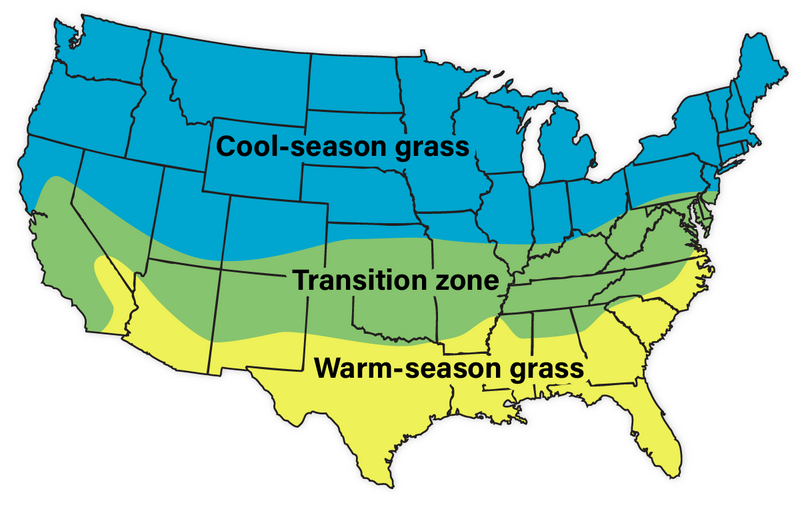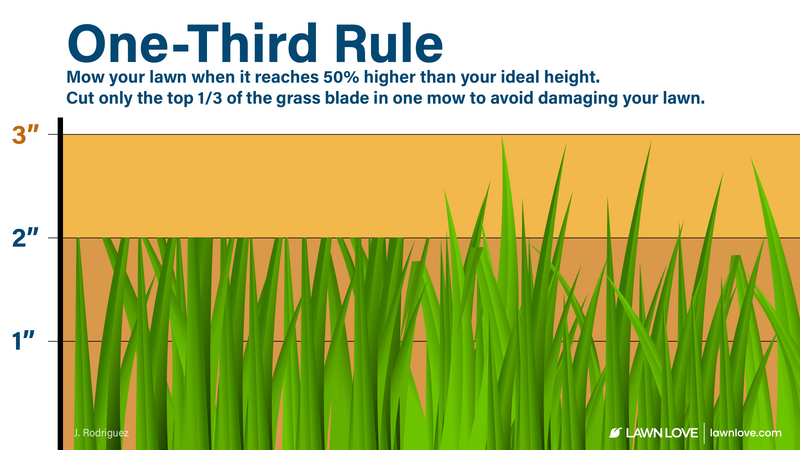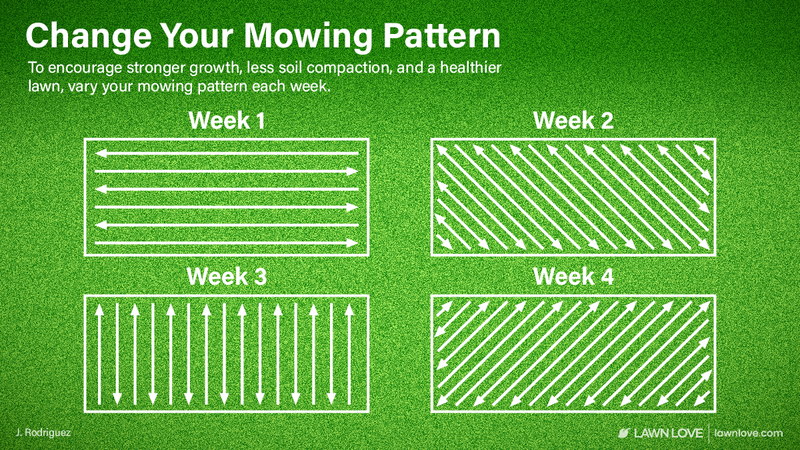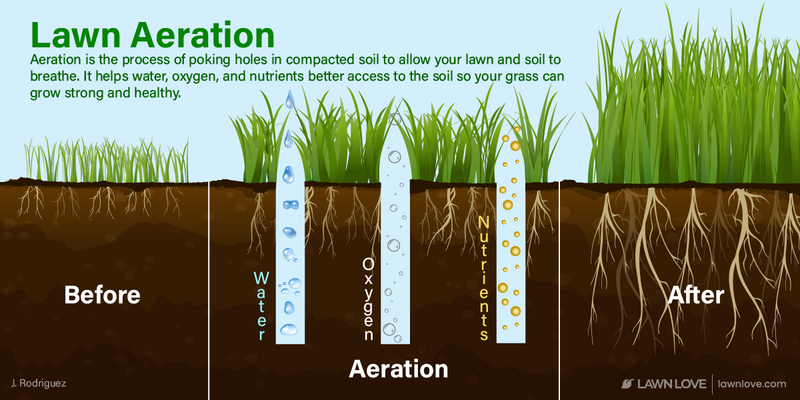
If you live in the northern U.S., you likely have cool-season grass. Cool-season grasses flourish in the cool weather of fall and spring and may go dormant in the hot summer months. These versatile grasses grow in the transition zone as well, further extending their reach in that hard-to-grow section of the country.
Where do cool-season grasses grow?

Cool-season turfgrass grows across the upper and middle bands of the U.S. These zones are called the cool-season zone and transition zone.
Cool-season grasses loathe the heat of summer and most often transition into dormancy. Some grasses will stay green with supplemental water. To keep a green color on your summer lawn without the extra expense on your water bill, use lawn spray paint to keep it emerald green.
If you live in the transition zone, check with your local Cooperative Extension office to ask whether cool- or warm-season grass is best. Some warm-season grasses, such as Zoysiagrass, have good cold tolerance and are often used in transition zone lawns.
Which types of cool-season grasses can I plant?
Choose from these popular cool-season turfgrasses:
- Fine fescue (includes chewings fescue, hard fescue, sheep fescue, slender creeping red fescue, and strong creeping red fescue)
- Kentucky bluegrass
- Perennial ryegrass
- Tall fescue
Annual ryegrass isn’t on our list since it isn’t a perennial turfgrass species.
How to grow cool-season grass
Learn how to seed, sod, and hydroseed a cool-season lawn.
| Grass type | Seed | Sod |
| Tall fescue | ✓ | ✓ |
| Perennial ryegrass | ✓ | ✓ |
| Kentucky bluegrass | ✓ | ✓ |
| Fine fescue | ✓ | ✓ |
Before you plant
Before you make a large investment in time, resources, and water, it’s a good idea to do the necessary prep work and set your lawn up for success. In addition to proper site preparation, a soil test will measure the pH, macronutrients, and various micronutrients. If you’re low on any of these nutrients, now’s the time to get your soil in balance.
Seed
DIYers and homeowners on a budget often choose to seed their cool-season lawn. With proper site prep, seeding at the right time of year, and proper watering, homeowners can achieve a healthy, full cool-season lawn with seed.
When you go to the store or search online, don’t be surprised to find cool-season grasses in a mix (more than one grass species in the bag). Cool-season mixes allow you to take advantage of the strengths of each grass and create a more resilient lawn.
When do I plant cool-season grass? The best time to plant cool-season grass is late summer or early fall. The second best time is in spring.
How often do I water? Water your new lawn one to three times per day until the grass germinates. Keep the soil moist but never soggy.
Sod
Cool-season sod can be installed any time of year, but fall is best. High summer temps (above 90 degrees Fahrenheit) mean some grasses won’t put down roots until soil and air temperatures drop. If this is the case in your lawn, keep it well-watered until these temps drop sufficiently and the grass starts to root.
Similarly, you can install cool-season sod in the coldest winter months (“dormant sodding”), but this is not ideal. It leaves the grass more at risk of winter injury and dry-out.
Hydroseed
Hydroseeding is the most economical option for a large lot. What is hydroseed? Hydroseed is a slurry of grass seed, fertilizer, stabilizers, and water that is sprayed onto the soil.
Hydroseeding is ideal for large areas and slopes. The thick consistency helps prevent erosion until the grass roots take hold. It is a popular solution for roadsides and large commercial areas as well as large home landscapes.
If you’re intrigued and want to learn more, check out our article, “Hydroseeding: How to Spray Grass Seed on Your Lawn.”
How to mow cool-season grass
Proper mowing is the foundation of good lawn care. Follow these easy tips to mow your way towards a healthy lawn.
One-third rule of mowing

The one-third rule of mowing is simple: Remove no more than one-third of the blade per mow. This sounds trivial, but it’s one of the most important things you can do for the health of your lawn.
Taking off more than one-third of the blade at a time puts too much stress on the grass. So, take it easy on your lawn. If the lawn gets a little too high, take the height down over a few mows.
How tall should you mow?
When you go to the hairdresser, you have a length in mind. So does your grass. Grass heights are specific to your grass species and have a huge impact on the health of your lawn.
For example, did you know that shoot growth and root growth mirror each other? The taller you cut the lawn (within its recommended range), the deeper the roots grow.
| Grass name | Ideal lawn height* | Mow when grass reaches this height |
| Tall fescue | 2-4 inches | 2.5-5.25 inches |
| Perennial ryegrass | 2-3 inches | 2.5-4 inches |
| Kentucky bluegrass | 2-3 inches | 2.5-4 inches |
| Fine fescue | 1.5-3 inches | 2-4 inches |
*These heights may vary slightly by region. Check with your local Cooperative Extension office for the best mowing heights for your area.
Mulch the clippings?
There are many reasons why it’s a good idea to mulch the grass clippings:
✓ Clippings do not contribute to thatch buildup
✓ Grass and leaf clippings are rich in nutrients, such as nitrogen
✓ Clippings supply up to 25% of your annual fertilizer for free
✓ Reduce landfill waste
✓ Help control erosion by keeping the soil covered
These are all good reasons to get out your mulching mower and leave these finely-chopped clippings on your lawn. However, there are a few cases when you’ll need to bag the clippings:
✗ If you have a fungus on the lawn.
–Dispose of these clippings in a green waste or trash bin.
✗ Too many leaves.
–If leaves cover more than half the lawn, bag and compost them.
✗ Weed seeds.
–If weeds have gone to seed, dispose of the clippings in a green waste bin.
✗ If the lawn is overgrown.
–If your lawn looks more like a prairie than a lawn, bag, and compost these clippings.
Keep the blade sharp
No one wants a dull, ragged-looking lawn. A sharp tool is an effective tool. Keep your mower blades sharp so that you’ll have a lawn that is nicely cut, not torn, and jagged.
Let the lawn tell you when to sharpen your blade. When you see grass blades that look torn instead of cut, it’s time.
Adjust your mowing pattern

Change up your mowing pattern each week and see what it does for your lawn’s appearance. This simple practice, which costs zero time or money, can help your lawn look more uniform and healthy, avoid ruts, and prevent the grass from leaning in one direction.
Here’s how:
- Week 1: Mow vertically
- Week 2: Mow diagonally
- Week 3: Mow horizontally
- Week 4: Mow diagonally (from the opposite direction in week 2)
Wait until it’s dry
No one likes to mow a wet lawn. Wet mows create ruts, contribute to soil compaction, and leave clumps of grass on your mower and lawn.
Sometimes you have no other choice, but avoid it if you can. If you see rain in the forecast, time your mowing before or well after for a healthier and better-looking lawn.
How to maintain cool-season grass
Water deeply
Plan to apply from 1-1 ½ inches of water per week if there’s no rain. Each grass and every lawn will present its own set of needs. So, how do you know when to water? Let the grass tell you. Look for wilt, color change, and footprints that stay on the lawn. When you see one or more of these symptoms, it’s time to water.
Water established lawns once per week to 10 days. Deep and infrequent watering sends the roots down into the soil to look for water. Shallow, frequent watering will create a shallow root system, weakening the lawn overall.
There’s a notable exception here: Sandy soils may need to be watered every few days, with a half-inch or so of water each time. Sandy soils don’t retain water well and need to drink more frequently.
Fertilize in the fall
In between football games and fall festivals, make room on your fall weekend calendar for cool-season lawn chores. Fall is the time to fertilize, aerate, dethatch, and overseed your cool-season lawn.
| Grass Type | How Much Nitrogen To Use (per 1,000 square feet per year) |
| Tall fescue | 1-3.5 pounds |
| Perennial ryegrass | 1-5 pounds |
| Kentucky bluegrass | 1-5 pounds |
| Fine fescue | 1-2 pounds |
Aerate to reduce compaction

What is aeration? Aeration opens up channels in the soil for more air, water, and nutrients to get through. Core aeration pulls plugs of soil from the lawn and is a boon to the short- and long-term health of your grass.
Aeration could be a great benefit to your lawn if you have:
- Frequent foot traffic on the lawn
- Vehicles or heavy equipment often on your lawn.
- Heavy, clay soil
- Compacted soil
Aerating your lawn in fall will make your grass healthier throughout the year.
Dethatch to get rid of that spongy layer

What is thatch? Thatch is a spongy layer of dead roots, stems, and other undigested organic matter that sits on top of the soil. Less than a half-inch is usually fine, but any more than that, and water and nutrients can’t reach the soil surface where they’re needed.
If you have these grasses, keep an eye on your thatch levels:
- Fine fescue
- Kentucky bluegrass
Once thatch reaches a half-inch or above, rent a dethatching machine in the fall (or use a hand dethatching rake for very small areas) to take care of this problem. If thatch and soil compaction are an issue, plan to dethatch and aerate for the best results.
Overseed to fill in the bald spots
If your lawn has succumbed to summer stresses, disease, or insects, why not throw down a little extra seed to fill in those gaps? Overseeding helps the lawn to have a full, thick appearance once again after the stresses of heat and summer.
Pro Tip: Plan to fertilize, aerate/dethatch, and overseed on the same day. Learn the “4 Steps to Overseed a Lawn” to make this fall lawn chore a snap.
Control unwanted weeds
Weed control is a never-ending chore, but there is hope. It takes consistent, persistent work, but you’re likely to see results over time.
Follow these three simple steps to reduce the pesky weeds in your lawn.
Step 1: What’s its name?
First, know what you’re dealing with. What’s its name? Once you ID your weed, you’ll know its good points,not-so-good points, and how to tackle it head-on.
Step 2: When does it grow?
Every weed has to germinate before it can grow. Broadleaf weeds fall into four categories:
| Type of weed | When it lives and dies | Example |
| Summer annual | Summer annuals germinate in spring, grow in summer, and die in fall or winter. | Crabgrass |
| Winter annual | Winter annuals sprout in fall or winter, grow in spring and die with the summer heat. | Common chickweed |
| Biennial weed | Biennial weeds live for two years. | Garlic mustard |
| Perennial weed | Perennial weeds live three or more years. | Dandelion |
Step 3: How to treat the weeds
Here are a few different approaches:
- The low-maintenance approach
Consider your weeds an asset to the ecological diversity of your lawn. Mow regularly, and nothing more.
- The intensive approach
Apply pre-emergents or post-emergents as needed to knock down these weeds before and after they sprout. (Remember, there are chemical and natural weed control options, even for intensive weed control.)
- The “I only care about my flower beds” approach
You hand-pull or treat weeds in your flower beds. Weeds in the lawn get the mow-only treatment.
Pro Tip: A full, dense lawn is the best defense against weeds.
Pests and diseases of cool-season grasses
Cool-season grasses have their share of unsightly diseases and pesky critters. Here are a few you may run across:
Common Diseases
- Gray leaf spot
- Dollar spot
- Rust
- Red thread
- Blight
- Snow molds
Common Insects
- Grubs
- Sod webworms
- Billbugs
- Aphids
- Armyworms
- Chinch bugs
The steps we outlined above for weed control (What’s its name?, When does it grow?, How to treat) also apply here. Follow these simple steps to gain control over these pesky lawn problems. And remember that your weekly and seasonal lawn maintenance go a long way in preventing and reducing the severity of lawn problems that crop up throughout the year.
If your fall season is too full, contact one of our local lawn care pros to take care of your seasonal and weekly lawn maintenance.
Main Photo Credit: Guillaume Meurice | Pexels